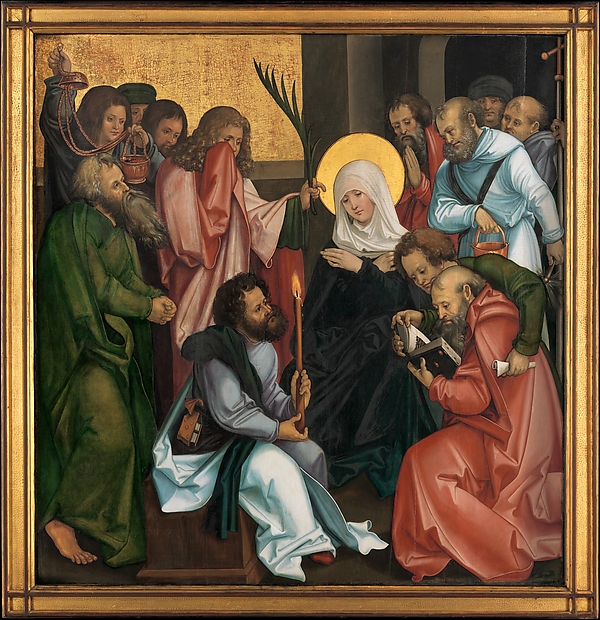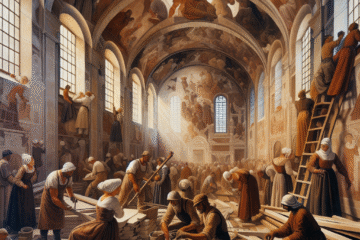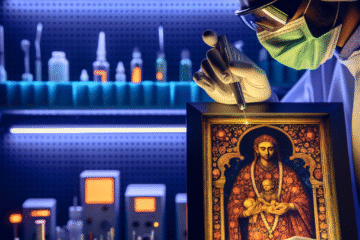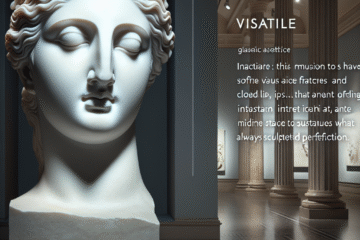
Image title: The Dormition of the Virgin; (reverse) Christ Carrying the Cross
Medium: Oil and gold on fir
Date: ca. 1510
Source:
The Met Collection
“
The cause is hidden. The effect is visible to all.
”
— Ovid
Invisible Masters: The Hidden Hands Behind Renaissance Workshops
Introduction: Beyond the Signatures
When we think of the Renaissance, names like Leonardo da Vinci, Michelangelo, and Raphael dominate our imaginations. These towering figures are often celebrated as singular geniuses, the embodiment of artistic brilliance. Yet behind each masterpiece bearing their signatures was a bustling atelier—an organized network of apprentices, journeymen, and anonymous masters who contributed to the creation of enduring works of art. This blog post aims to pull back the velvet curtain on these “invisible masters,” exploring the layered world of Renaissance workshops and the collaborative spirit that defined them.
Chapter 1: The Gothic Roots – Craft Over Celebrity
Before the Renaissance redefined the role of the artist, the production of art in medieval Europe was largely a communal and guild-regulated affair. The Gothic period (12th–14th centuries) placed emphasis on the collective rather than the individual. Painters and sculptors were considered craftsmen rather than creators, embedded within guild systems similar to blacksmiths or weavers. Workshops were typically anonymous, and the decorative programs of Gothic cathedrals were the fruits of collaborative teams whose names rarely surface in historical texts. The emphasis was on transmission of style and knowledge, not personal fame—a philosophy that would carry into the early Renaissance, albeit in evolving forms.
Chapter 2: The Quattrocento Atelier – A Renaissance Assembly Line
With the dawn of the 15th century—the so-called Quattrocento—Italy saw the rise of the modern image of the “artist.” Figures like Masaccio and Fra Angelico began to emerge with identifiable styles, yet much of their work was still produced in studios brimming with assistants. Florence, the epicenter of early Renaissance art, witnessed booming demand for frescoes, altarpieces, and devotional panels, leading to highly organized workshops functioning like small factories. Apprentices learned by copying their master’s style, adding backgrounds, layering gold leaf, or painting minor figures. Documents from this time reveal job contracts specifying exactly what parts of a composition a master versus an assistant would tackle. Some workshops even had unwritten ‘house styles’ that persisted long after the founding master had passed away.
Chapter 3: High Renaissance and the Myth of the Genius
The High Renaissance (c. 1490s–1527) saw the consolidation of the “artist as genius” ideology, heavily shaped by the writings of Vasari and others. Masters like Leonardo, Raphael, and Michelangelo were elevated to divine status, treated less like craftsmen and more like prophets. Despite this, their monumental commissions—such as the Vatican Rooms or the Sistine Chapel ceiling—remained vast logistical undertakings enabled by robust workshops. Raphael’s studio, for instance, included over fifty assistants at its height. His pupil Giulio Romano would later complete many of Raphael’s unfinished commissions after his death. These collaborative endeavors blurred the lines between authorship and execution, yet popular and patron perception favored the idea of singular creative genius—a myth that persists in modern art historiography.
Chapter 4: Techniques and Technology – The Hidden Language of Workshops
Technological advances also shaped the structure and output of Renaissance ateliers. Innovations like oil paint (perfected in the North by artists such as Jan van Eyck) and linear perspective (formalized by Brunelleschi and Alberti) changed the demands placed upon artists and their teams. New methods enabled multiple hands to participate in a single cohesive artwork without disrupting the illusion of unity. Underpainting techniques, grid transfers, and detailed cartoons allowed a master’s vision to be efficiently replicated by assistants with remarkable fidelity. This use of technology and precise workflow hints at early forms of automation and reproducibility, making Renaissance workshops precursors to both industrial production and contemporary digital studios.
Chapter 5: Reclaiming the Forgotten Hands – A New Historiography
Modern scholarship is increasingly seeking to identify and credit the artisans who labored behind the scenes. Technical tools such as infrared reflectography and X-ray fluorescence have begun to reveal underdrawings and paint layers, distinguishing the hand of the master from that of his apprentices. Art historians now talk about “the studio of Leonardo” or “the workshop of Verrocchio” to acknowledge this collaborative nature. Exhibitions and publications are starting to highlight lesser-known contributors like Antonio del Pollaiuolo or Domenico Ghirlandaio’s many anonymous employees. As we gain deeper understanding of the complexities of workshop dynamics, the conversation shifts from singular attribution to appreciation for the intricate web of mentorship, labor, and influence.
Conclusion: Collaboration as Creation
The story of Renaissance art is richer and more complex when we look beyond individual geniuses to the vast networks of skilled artists who supported them. These “invisible masters” not only executed but often innovated, ensuring the survival and proliferation of styles, techniques, and ideas. Recognizing their role not only broadens our historical view but also challenges contemporary assumptions about creativity, labor, and authorship. The beauty of a Raphael Madonna or a Titian altarpiece becomes all the more profound when seen as a collaboration—an echo of many minds, many hands, and many souls working toward a shared vision of the divine.

Image description:
Catedral de Orense. Arqueta-relicario de marfil y taracea de maderas preciosas, procedente del Taller de Embriachi. Presenta tallada en marfil la Historia de Susana. En esta arqueta se depositaron las reliquias de Santa Eufemia. Obsequiada a la catedral en 1529, procedente del Saco de Roma.
License:
CC BY-SA 4.0
Source:
Wikimedia Commons


